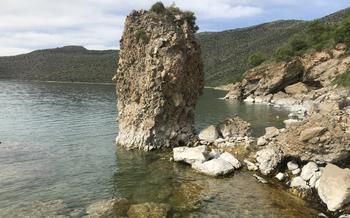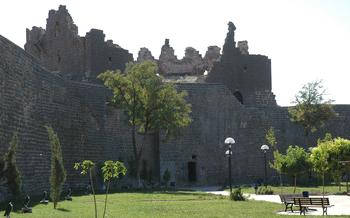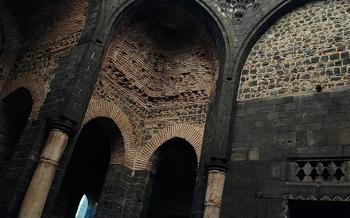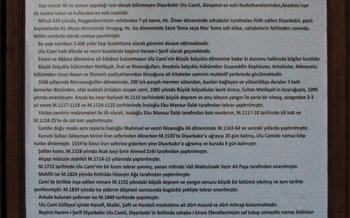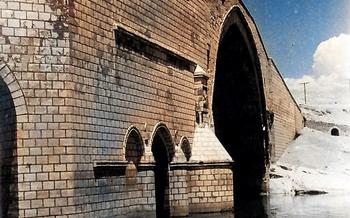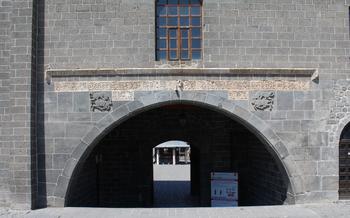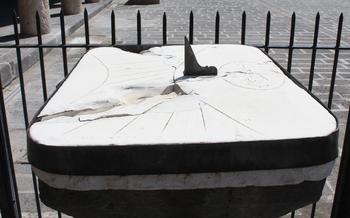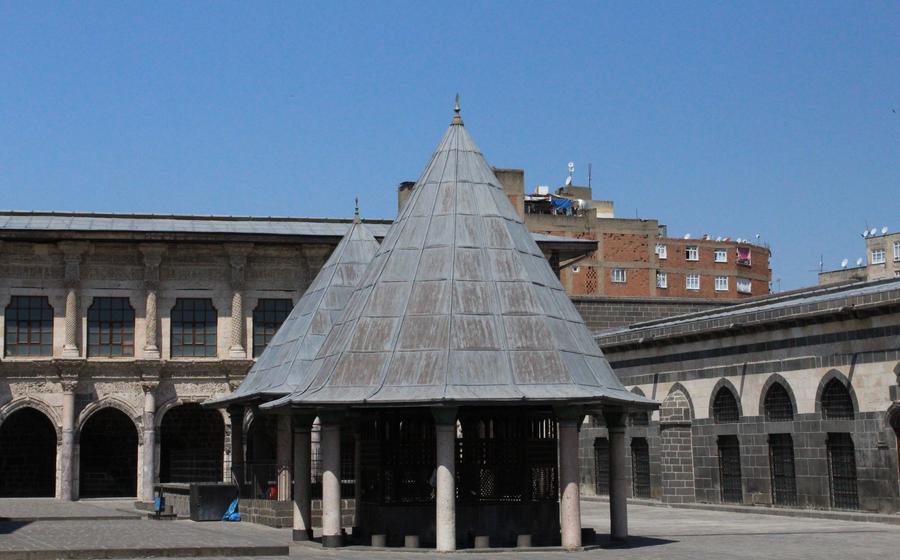
Kasımiye Medrese
- Background and Significance of the Madrassa
- Location and Accessibility
- Architectural Highlights
- Interior Features
- Educational and Cultural Significance
- Current Use and Function
- Significance for Visitors
- Tips for Visiting
- Guided Tours and Resources:
- Nearby Attractions
- Local Cuisine and Restaurants
- Shopping and Souvenirs: A Blend of Tradition and Modernity
- Accommodation Options
- Insider Tip:
Background and Significance of the Madrassa
Kasımiye Medrese stands as a testament to the rich Islamic heritage of Diyarbakır. Established in the 16th century by the Kurdish ruler Sultan Kasım Paşa, this madrasa holds a significant position in the history of Islamic education and architecture. As one of the most prominent madrasas in the region, it served as a center of Islamic learning, perpetuating the study and dissemination of Islamic knowledge for centuries. The madrasa's enduring legacy is evident in its splendid architecture, which harmoniously blends Anatolian and Seljuk influences, showcasing the region's architectural prowess and artistic legacy.
Location and Accessibility
The Kasımiye Medrese is situated in the heart of Diyarbakır's historical center, just a short walk from the iconic Great Mosque. Its address is Fatihpaşa Mahallesi, Medrese Sokak No:To reach the madrasa, visitors can conveniently take public transportation, with several bus lines stopping nearby. The Yenişehir Bus Station is a major transportation hub located within walking distance. Alternatively, visitors can opt for a leisurely walk through the charming streets of Diyarbakır, admiring the surrounding historical landmarks. Limited parking is available in the vicinity, making it advisable to explore the area on foot or by bicycle.
Architectural Highlights
The Kasımiye Medrese is a stunning masterpiece of Islamic architecture, showcasing a harmonious blend of Seljuk and Ottoman influences. Its most striking feature is the magnificent dome, which dominates the skyline and serves as a symbol of the madrasa's grandeur. The dome is supported by intricate stalactite pendentives, creating a sense of lightness and airiness within the interior. The four minarets, one at each corner of the madrasa, add to its majestic presence, accentuating its verticality and providing a visual anchor for the entire complex.
The courtyard of the madrasa is a tranquil oasis, surrounded by elegant arches and colonnades. The courtyard's central fountain adds a touch of serenity and complements the soothing atmosphere of the space. The surrounding walls are adorned with intricate carvings and decorative tiles, showcasing the exceptional craftsmanship and attention to detail that went into the madrasa's construction.
Interior Features
The interior of the Kasımiye Medrese is as impressive as its exterior. The madrasa's layout follows the traditional design of Islamic educational institutions, with a central courtyard surrounded by iwans (arched recesses) and rooms. The courtyard, adorned with intricate tilework and decorative columns, creates a serene and contemplative atmosphere, conducive to learning and contemplation.
One of the most striking features of the madrasa's interior is its prayer hall, located on the south side of the courtyard. The prayer hall is adorned with a magnificent mihrab, an intricately carved niche indicating the direction of Mecca. The mihrab is flanked by two minbars, elevated platforms used by the imam to deliver sermons. The prayer hall's high ceiling, supported by graceful columns, creates a sense of grandeur and awe.
Surrounding the courtyard are numerous rooms that served as classrooms and living quarters for the students. These rooms are relatively small and simple, reflecting the ascetic lifestyle of the students. However, they are adorned with beautiful calligraphy inscriptions and decorative motifs, adding a touch of elegance to the otherwise austere spaces.
Another notable feature of the madrasa's interior is its library, located on the east side of the courtyard. The library houses a rich collection of Islamic manuscripts and books, covering various subjects such as theology, philosophy, law, and science. The collection is a testament to the madrasa's role as a center of Islamic learning and scholarship.
Educational and Cultural Significance
The Kasımiye Medrese stood as a beacon of Islamic learning, attracting scholars and students from across the region. Renowned for its academic excellence, it produced generations of Islamic scholars, jurists, and theologians who made significant contributions to the development of Islamic thought and jurisprudence. Among its notable alumni were Qadi Muhammad, a prominent jurist and scholar of Hadith, and Sheikh Bedreddin, a renowned theologian and mystic.
The madrasa's curriculum encompassed a wide range of Islamic disciplines, including theology, jurisprudence, Qur'anic studies, and Hadith. It also offered instruction in secular subjects such as mathematics, astronomy, and medicine. The madrasa's library, renowned for its vast collection of Islamic manuscripts, served as a repository of knowledge and a resource for scholars from far and wide.
Beyond its educational role, the madrasa played a vital role in the preservation and transmission of Islamic knowledge. It served as a center for the transcription and dissemination of Islamic texts, contributing to the preservation of the Islamic intellectual heritage. Through its teaching and scholarship, the Kasımiye Medrese played a pivotal role in the intellectual and cultural development of the region, leaving a lasting impact on Islamic thought and learning.
Current Use and Function
Today, the Kasımiye Medrese stands as a testament to its enduring legacy as a center of Islamic learning. While it no longer functions as an active educational institution, the madrasa has been meticulously restored and preserved to serve as a museum and cultural center. Visitors can immerse themselves in the rich history and architectural splendor of this iconic landmark, gaining insights into its pivotal role in the dissemination of Islamic knowledge. Ongoing conservation efforts ensure that the madrasa's pristine condition and historical integrity remain intact for generations to come.
Significance for Visitors
The Kasımiye Medrese is a must-visit site in Diyarbakır for its unique historical, architectural, and cultural significance. Its well-preserved state and stunning architecture make it a visual feast for visitors interested in Islamic art and design. The intricate carvings, inscriptions, and decorative elements showcase the skill and artistry of past craftsmen and provide valuable insights into the region's rich Islamic heritage.
Beyond its architectural splendor, the madrasa's significance lies in its role as a center of Islamic learning. Visitors can explore the classrooms and library, where once renowned scholars gathered to impart knowledge and wisdom to students. The presence of prominent Islamic scholars and the preservation of valuable manuscripts here highlight the madrasa's contribution to the transmission of Islamic knowledge throughout history.
Visiting the Kasımiye Medrese offers a unique opportunity to delve into the heart of Diyarbakır's Islamic heritage and gain a deeper understanding of the city's cultural identity. It is a site that captivates history buffs, architecture enthusiasts, and anyone seeking to immerse themselves in the region's rich past.
Tips for Visiting
To fully appreciate the architectural and cultural significance of the Kasımiye Medrese, it's recommended to allocate at least an hour for your visit. The best time to visit is during the morning or late afternoon, when the sun's rays illuminate the intricate carvings and details of the building. Reservations or tickets are not required, and the entrance is free of charge.
When visiting the Madrese, it's important to dress respectfully, covering shoulders and knees. Visitors should also be mindful of the sanctity of the site and maintain a respectful and quiet demeanor. Photography is permitted, but using a flash is not allowed as it can damage the delicate artwork and manuscripts.
For those seeking a deeper understanding of the Madrese's history and significance, guided tours are available in English and Turkish. These tours provide insights into the architectural features, educational legacy, and cultural importance of the building. Visitors can inquire about guided tours at the entrance or through local tour operators.
Guided Tours and Resources:
To enrich your visit to the Kasımiye Medrese, consider joining a guided tour. These tours, often led by local experts or historians, provide in-depth insights into the madrasa's architecture, history, and significance. They can help you understand the intricate details and stories behind this magnificent structure, making your visit even more meaningful.
Several tour companies and guides offer guided tours of the Kasımiye Medrese. To find a reputable and knowledgeable guide, check with your hotel concierge or local tourism offices. Online platforms like GetYourGuide and Viator also offer a range of guided tours with varying durations and prices.
Before your visit, it's a good idea to do some research on the madrasa's history and architecture. This will help you better appreciate the explanations and stories shared by your guide. You can find informative articles, books, and documentaries online or at local libraries.
At the madrasa, you'll find a visitor center that provides brochures, maps, and general information about the site. The staff at the visitor center can also answer any questions you may have and direct you to the starting point for guided tours.
Enhance your visit further by downloading a mobile app or audio guide. These resources offer self-guided tours with detailed explanations, allowing you to explore the madrasa at your own pace. Audio guides are particularly useful if you prefer to learn about the site independently or in a language other than Turkish.
With guided tours, visitor centers, and various resources available, you'll have all the tools you need to make the most of your visit to the Kasımiye Medrese.
Nearby Attractions
The Kasımiye Medrese is situated in the heart of Diyarbakır's historical center, surrounded by a wealth of other attractions that showcase the city's rich history and culture. Visitors can embark on a leisurely walking tour to explore these nearby gems.
Start by heading to the Diyarbakır Fortress, a UNESCO World Heritage Site that encloses the old city. Marvel at its imposing walls and towers, which have stood guard over Diyarbakır for centuries. Explore the atmospheric streets within the fortress, where you'll find traditional shops, cafes, and historic mosques.
Next, visit the Great Mosque of Diyarbakır, one of the oldest and most significant mosques in Turkey. Admire its stunning architecture, which blends Seljuk and Ottoman styles. Step inside to witness the intricate tilework, calligraphy, and a mihrab that dates back to the 11th century.
For a glimpse into Diyarbakır's Christian heritage, visit the Mor Gabriel Monastery, located just outside the city. This ancient monastery, founded in the 4th century, is one of the oldest continuously inhabited Christian monasteries in the world. Explore its beautiful church, adorned with frescoes and carvings, and soak in the serene atmosphere of this holy site.
Combine your visit to the Kasımiye Medrese with these nearby attractions to create a comprehensive and enriching exploration of Diyarbakır's historical and cultural treasures. Walking routes and itineraries are available at the Diyarbakır Tourism Information Center, where you can also purchase combined tickets for multiple sites to save on admission fees.
Local Cuisine and Restaurants
A visit to Diyarbakır is incomplete without savoring the city's unique culinary delights. The city's cuisine is a blend of Turkish, Kurdish, and Armenian influences, resulting in a rich and diverse culinary landscape. One must-try dish is "kaburga dolması," a succulent lamb shank stuffed with rice and spices. "Mırra," a local soup made with lamb, tomatoes, and eggplant, is another popular dish. For a taste of traditional street food, try "çiğ köfte," a spicy raw meatball dish served with fresh vegetables and herbs.
When it comes to restaurants, Diyarbakır offers a range of options to suit every taste and budget. For an authentic local experience, head to "İmam Çağdaş," a renowned restaurant serving traditional dishes in a charming ambiance. "Kebapçı Halil Usta" is another popular choice, known for its delicious kebabs and grilled meats. For a more upscale dining experience, "Diyarbakır Sofrası" offers a refined menu of regional specialties in a stylish setting.
Diyarbakır's cuisine is not just about taste; it's also deeply intertwined with the city's history and culture. Many dishes have been passed down through generations, carrying with them stories of the region's diverse heritage. Experiencing the local cuisine is a fantastic way to immerse yourself in the rich tapestry of Diyarbakır's cultural identity.
Shopping and Souvenirs: A Blend of Tradition and Modernity
As you stroll around the vicinity of Kasımiye Medrese, you'll encounter a vibrant array of shops and markets that showcase the rich cultural heritage of Diyarbakır. From bustling bazaars to quaint boutiques, there's no shortage of places to find unique souvenirs and handicrafts.
For a truly authentic experience, head to the Coppersmiths' Bazaar, where skilled artisans meticulously craft intricate copperware using traditional techniques passed down through generations. Admire their mesmerizing handiwork as they transform sheets of copper into stunning objects d'art, from ornate trays and pitchers to decorative lamps.
If textiles and fabrics are more your style, explore the vibrant alleys of the Old City, where you'll find an abundance of shops selling colorful kilims, intricately woven rugs, and traditional Kurdish textiles. These handmade creations are not just visually appealing but also carry deep cultural significance, representing the region's rich weaving traditions.
For those seeking contemporary souvenirs, Diyarbakır offers a range of modern boutiques and galleries showcasing the works of local artists and designers. Discover unique jewelry, hand-painted ceramics, and contemporary art inspired by the city's rich history and culture.
Remember, bargaining is a way of life in Diyarbakır's markets, so don't hesitate to engage in friendly negotiations with the shopkeepers. It's not just about getting a good deal; it's also a way to connect with the locals and learn more about their culture.
Whether you're looking for traditional handicrafts, modern art, or simply a memento to remember your visit, Diyarbakır's shopping scene offers a delightful blend of tradition and modernity.
Accommodation Options
When choosing a place to stay in Diyarbakır, there are several options to suit different preferences and budgets. For an authentic experience, consider staying in a traditional Ottoman-style guesthouse or boutique hotel within the city's historic center. These accommodations often feature unique architectural details and offer a glimpse into the region's rich history.
For those seeking modern amenities and convenience, there are several reputable hotels located near the Kasımiye Medrese. These hotels provide comfortable accommodations, easy access to local attractions, and often have amenities like restaurants, pools, and fitness centers.
For a truly immersive experience, consider staying in a nearby village or town and exploring Diyarbakır on day trips. This option allows you to experience the local culture more closely and discover hidden gems off the beaten path.
Overall, Diyarbakır offers a range of accommodation options to cater to different needs and preferences. Whether you prefer a traditional guesthouse, a modern hotel, or a village stay, you'll find suitable options to make your trip comfortable and memorable.
Insider Tip:
During my visit to Kasımiye Medrese, I stumbled upon a hidden gem – a rooftop terrace that offered unparalleled views of the city. While not usually accessible to visitors, I managed to persuade one of the caretakers to let me up. The panoramic vista was breathtaking, allowing me to witness the city's beauty and the sheer scale of the madrasa's grandeur. For those seeking an unforgettable perspective, I highly recommend trying to negotiate access to this secret viewpoint.

